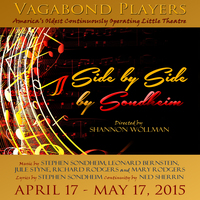While Into the Woods may be all the rave in the world of Stephen Sondheim right now, the Vagabond Players takes a step back to a simpler time in the musical master’s history. The earlier works all bound together in a magically enchanting evening; one musical revue to thoroughly enjoy an evening of intimate musical theatre is now opening on the stage as the second musical show in their 99th season. TheatreBloom sits down in an exclusive interview with Director Shannon Wollman as she makes her directorial debut with the piece and get to hear all about just why this musical is going to be so spectacular.
If you could tell us a little about yourself so that our readers can get a handle on where they might recognize you and your work, that would be a great start!
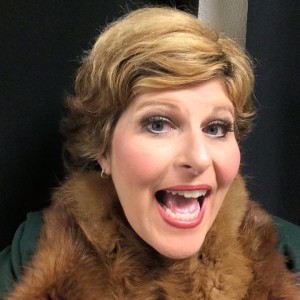
Shannon Wollman: I’m Shannon Wollman, born and raised in Baltimore. Lived in New York for about ten years after college, moved back to Baltimore in 2000 and have been back ever since. I pursued the acting career thing in New York, did cruise ships, national tours and that kind of life. But the time I didn’t work outweighed the time I did work while doing the theatre thing and it just wasn’t working for me. There’s that .01% that gets job after job after job and everyone else struggles. I’m not a good struggler. I never really did professional theatre until I graduated high school. Now, I always loved theatre and I always knew it was what I wanted to do. I took ballet class growing up and I did the school plays but I didn’t have the stage mother who was pushing me into that life and putting me in academies and all that. I’m kind of glad about that because I grew up as a normal teenager. I had a childhood.
But I grew up listening to my albums. I had albums for every single show, plus my parents loved the theatre. They took me to see shows, and I loved it. I always knew I was going to do it in my adult life. I graduated high school and that summer I did my first dinner theatre show. It was Towson Town Dinner Theatre— and you have to remember in the 80’s and 90’s dinner theatre was huge in Baltimore— it was in the chorus of They’re Playing Our Song. And that was my first venture in professional theatre. It was great fun and it changed my path, interestingly enough. I was actually set to go to College Park, University of Maryland. But that summer I had such a good experience and made so many friends so quickly, as you can imagine you do in the theatre community— and about three quarters of those people are still close friends of mine today, it’s just that tight-knit type of community— but I realized somewhere in the middle of that summer that I just really did not want to go away to school. I wanted to stay in Baltimore.
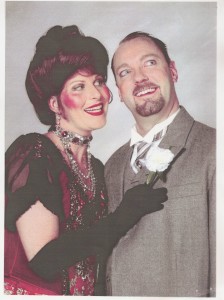
So I thought I could go to college locally and stay in the dinner theatre circuit. At the time there was a huge availability for that. Probably close to a dozen of them in and around Baltimore. So I did. I wound up going to Towson and was a theatre major there. During my five years there— from ’86 to ’91— I did a bunch of different dinner theatres. I did Fanny Brice in Funny Girl, Ellie Greenwich in Leader of the Pack. So many, maybe too many to remember. I was really lucky that for the first year or two I was in the ensemble, which really helped me get my feet wet. From there I had this great opportunity to play a lot of leading ladies and it was awesome. I’ve done Mame, Dolly Levi, all of those recognizable big musical theatre characters. Adelaide in Guys and Dolls. There have just been so many great roles over the years.
It’s been wonderful to get all of these roles onto my resume. I was very lucky, I was a big fish in a little pond here and I had a lot of roles. But then I got to New York and you’re suddenly at auditions with a lot of big fishes from little ponds. Everyone is talented, it’s not just you anymore. And it’s very hard. Now in-between finishing college and going up to New York, Larry (Co-Artistic Director of Toby’s Dinner Theatre, Lawrence B. Munsey) and I both got cast in the National Tour of Gypsy. I had never really been away from home before, so it was fun. I played Elektra, I got to see the United States, a lot of one nighters. I met a lot of good friends on that tour and we were all kind of in the same place in our lives. Most of us had just graduated college and we all ended up moving to New York together. It was great for Larry and I to have that opportunity together.
My roommate in New York, Jennifer Cody— who does a lot of work in New York nowadays— we met on that tour of Gypsy, and we moved up there together. Now she’s still one of my closest friends, I was Maid of Honor in her and Hunter Foster’s wedding. So you make these lasting relationships. Where else was I going with that? Oh— getting the work in New York. It was hit and miss but I wound up getting more work back here in Baltimore. Like I would come back to do a summer with Maryland Arts Festival and I got all these offers to do shows here. I was a great waitress, I was a really good temp, and I had some fun things happen during my time up there in New York, but where I ended up making my niche was in Cabaret work.
How do you feel about your Cabaret work? How is it different from your stage work?
It was something I enjoyed and it was something that I really connected with. I started working at places like “Don’t Tell Momma” and places like that. I realized it was a really good genre for me. I love playing a character on stage and being in a show with a script and telling that story. But what I really enjoy is being able to connect to the audience the way that you can in Cabaret show that you can’t in a regular show. This is actually a great segue for the show I’m currently directing at Vagabond Players, Side by Side by Sondheim.
How did that opportunity come about, you getting to direct a musical revue— the second this season for the Vagabond Players— this spring?
Shannon: When I moved back to town in 2000 I became a real person. I got a day job and decided that theatre would be on the side. But as I’ve gotten older and do more shows, maybe one or two a year, I’ve realized that I’m much more vocal during rehearsals with my ideas and opinions. Finally I said, “I have to put my money where my mouth is and I think it’s time for me to try and direct something.” I had never directed before. This is my directorial debut. So I thought I needed to see what it was like to be on the other side of things. And I’m either going to find out that it’s better for me as a performer to show up to rehearsals, do my part, and keep my opinions to a low roar, or that this is really something I’m good at.
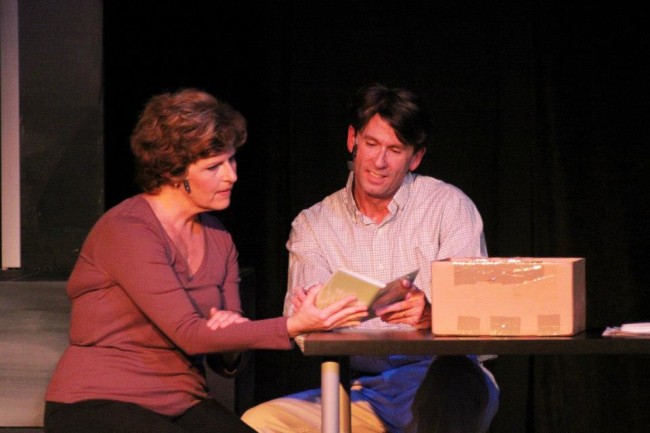
Now, why Side by Side was the perfect opportunity for me to make my directorial debut is because of my love for Cabaret. A show like this is much more about the music. It’s a night of music almost exactly like a cabaret. I feel like it is something that I happen to be good at. I feel like that is something that I just have an ability to connect to; I connect with people in the audience when I’m in a cabaret— that’s why my day job— I’m in fundraising— because it’s all about relationship building and being able to connect with people.
I said to Vags, I’d really like to be able to direct this season. They presented me with the opportunity to choose the show. My niche has always been musical theatre. I played Billie Holiday in Born Yesterday at Maryland Arts Festival, which was great. But maybe as I get older, because I think there will be less opportunity for good musical theatre roles for me, I’ll do more non-musical shows. I’m at a weird age right now where I’m too old to play a lot of the leading ladies but I’m not quite old enough to play some of the other characters that are a little older. So at this point I might try to get into some more plays. But anyway, I told them I wanted to do a musical revue.
Not only is this show my directorial debut but this is the first season where VAGS is doing two musicals in one season. And the first musical they did this year happened to also be a revue. It was ironic, I think they really wanted to do a more traditional musical in the first half of the season and then a revue in the spring but it just worked out that it was two revues. I thought this show would be a good match for me. It presented an opportunity for me to take a bunch of talented singers who don’t normally find themselves in musical revues or cabaret and help them show that side of themselves.
What is your cast like for this show?
Shannon: It’s been a lot of fun. I have some really talented people. I have four people, two women and two men. Steve Antonsen, Gary Hiel, Jennifer Viets, and Alyson Shirk; those are my four. Jennifer was in Company last year with me at VAGS, but she’s done a ton of stuff all over Baltimore. She’s a beautiful singer, great voice. She’s a fun actress and she’s a dancer as well. I chose the people that I chose because I knew they were great singers. But I also knew they all had great personalities. With any show, but especially in revues and cabaret, you have to have strong personalities that really speak to the audience.
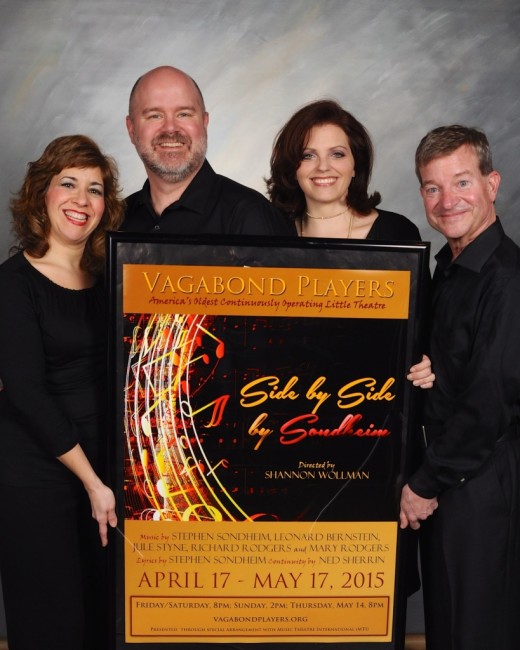
What’s so interesting, and has really been quite challenging, is getting this group to be comfortable enough to remove the curtain from the fourth wall and really play to the audience. I don’t think that’s everybody’s comfort zone and I forget that because it is mine. I can see it growing with each rehearsal that they are getting more and more comfortable with doing that. It’s a great show because it’s all of Sondheim’s earlier music compared to a lot of the revues out there that focus on his later works.
It’s interesting that you mention that because with the cast that you have, you could have very easily picked any musical revue, like I Love You, You’re Perfect, Now Change. Why this revue?
Shannon: I think I wanted to do Sondheim. I wanted a show where all of the songs were story-telling songs. I’m a story teller. I’m all about entertaining, but if you’re going to do a revue— A.) An audience enjoys a revue of music that they know much more than music that they don’t. That’s not to say that revues like I Love You, You’re Perfect Now Change aren’t great shows. But there’s hardly any recognizable music in that show. I wanted to choose a show where everybody would know the songs, or at least 90% of the songs. Now this revue does have a couple of tunes that aren’t very recognizable but I think that’s kind of neat.
One song is “I Remember Sky.” Now if you’re a Broadway person you might know it, but most people don’t know it. Stephen Sondheim wrote it for a made-for-television movie that starred Anthony Perkins. It’s a beautiful ballad that a lot of men will choose to incorporate into their cabaret shows, but it’s not very well known. There’s another song from a show called The Mad Show, which had the shortest run in Broadway history, I think. This was a musical satirical show based on Mad Magazine that he wrote the score for, interestingly enough when he penned it he didn’t use his own name. But the song that Jenn does in this revue from that show is so hysterical.
So there’s one here or there that people won’t recognize. But the majority of the music featured in this show is from West Side Story up until Pacific Overtures. That includes those two, Gypsy, Company, Follies. You know not Into the Woods, not Sweeney Todd, because those are all later in his history. A Little Night Music, Forum, all of those earlier works that people recognize.
Now the show was originally a musical revue created in the West End in the 70’s. It was the first musical revue of Sondheim’s stuff. It was brought over to New York and originally it was written for two women and a man. And a narrator. There’s not really a whole lot of dialogue. There is a little bit from the narrator that gives background information on some of the songs and on Sondheim. But I decided that I did not want to have a narrator. I’d rather have two men and two women and have the cast share in the narration. So that’s what we’re doing. And for me I find that more interesting.
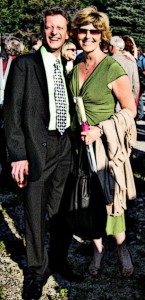
Now it’s just done with a piano. Sometimes it’s done with two pianos. Sometimes it’s done with a little band, but we’re doing it with just a single piano. And it’s Doug (Musical Director Douglas Lawler.) And you can’t get any better when it comes to Doug Lawler as far as Musical Directing and being the accompanist for the show. He and I have been friends for years. And honestly? If he had not been available for this show, I’m not sure I would have wanted to do it. That’s the honest to goodness truth. It’s such a huge part of the show, the pianist. I wanted someone who I trusted musically for this— there are 27 songs in this show.
What’s also fun about this show— because you’re working with a limited number of people— you have to reinvent some of the songs a little bit. So sometimes there will be men singing women’s songs. Or rather, those songs that we identify as traditionally being sung by a woman, will now be being sung by men. And vice versa. It brings a different perspective to the song and I love it.
How are you setting up costumes, props, and sets for this show?
Shannon: Very basic and very minimal. From the get-go that was the vision that I had for it. Right from the beginning I have just wanted this to be all about the music; that’s what the core of this is. I’m also having everybody wear black. I said to them “I want all attention drawn to your face. I want it to be all about your eyes, your expression, your singing, and your story telling.” I didn’t want anything distracting. If they’re all in black, your eyes are automatically drawn to their face. The set is very, very basic. There are a few pieces that help to shift the atmosphere and location. Oh, and we have a baby grand. Kudos to Maryland Piano!
Normally the musicals at VAGS are done with an electric keyboard. I knew if we were going to do this, we had to do this right. Not that Doug can’t make any kind of piano sound fantastic, but it just adds a whole other level of beauty to the production. That’s really what I wanted in terms of main focal pieces on the stage. That’s another part of why the stage is so simple. It’s about the music and the lyrics. That’s why simplicity works for this.
Is there a song in this revue that speaks to you the most?
Shannon: That’s a really good question. I think it’s “Losing My Mind” from Follies. It’s one of my favorite Sondheim songs. I think he is so good at writing lyrics that— and I hate to say it— are sad and soul-searching. It’s very true to his person, he’s had a very tragic life. When I watched Six on Sondheim, I learned so much about him that I didn’t know, his past and his childhood; all that sadness that he has carried with him throughout the years. “Losing My Mind” is one of those songs that just gets me. I mean we’ve all had that point in our lives where we are so lost in love, a lot of the time with people that we shouldn’t be. I think sometimes it’s the people that you shouldn’t be in love with that you do lose your mind about.
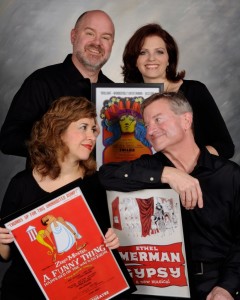
The people that are the healthier relationships, you’re never taken to that place of absolute loss and not knowing how to function without them. It’s almost like you’re addicted to that love. That’s what I love about “Losing My Mind” because it so perfectly and so eloquently expresses what it’s like when you are drowning in love with someone. And we’ve all been there. I’ve certainly drowned in love before. Thank goodness I’m in the best relationship of my life right now with someone who came along with a life preserver. It took me a long time to find her. You know it wasn’t until I was in a place in my where I was really satisfied with my existence that I met Melissa. Once I was, that’s when my taxi light went on. Up until that point I was always searching and loving the wrong people.
What has doing this show taught you about yourself as a director?
Shannon: I’ll tell you the first thing that comes to mind. I’ve never focused so much on storytelling of a song. Personally, you try to connect and tell the story, but I think sometimes musical theatre performers get a little lost in wanting to sound fantastic. They get caught up in sounding technical and perfect as opposed to an actor who is trying to give the best monologue from the best acting standpoint. We focus a little more on what we sound like rather than on the words we’re singing. I’ve realized through talking with the performers and really sitting down with them to figure out what a song means to them, that you can break a song down into its story to help coach them to tell it more thoroughly.
It’s made me realize that I want to focus more on the storytelling of these songs as a performer going forward. It’s that important. In watching them enhance their storytelling while we’re in rehearsal has made this whole experience so much better. I said to myself, “Oh my God it really does make a difference to that number in the way you tell that story.” I think I’m going to be paying much more attention to that for myself moving forward. It’s so true; it’s all about the story. I keep saying to them and Doug keeps saying to them— actually Doug started it.
Doug said to them, “Listen, everybody has already heard the most iconic version of every single one of these songs. We’ve all heard Bernadette Peters or Larry Kurt. Someone phenomenal has already done these songs and you are not going to sing it as well as that person.” We all know this. Let’s just face the reality of it. But what you can do is bring your own to it and bring the story to it. I think that’s so key. I keep saying to the group we all know you’re talented; you sound great, but tell me the story. Every note doesn’t’ have to be perfect. You don’t have to hold on to every note.
I want them to connect to the people in the audience. They’re invested in these characters and invested in telling the story and it makes for an amazing experience. Now, with all of that said, therein lies another challenge. It’s hard to tell the story of a song out of context of its show. That comes with a double-edged sword. A song like “Marry Me a Little” from Company is really difficult. By the time that song happens in the show, you’ve met Bobby and you understand his complexities and why it’s so challenging for him. But if you’ve not seen that show or know the character up to that point, it’s hard for the performer to tell that story and embody all that. That’s an ongoing work in progress. For the actor that’s their main challenge and they’re out of their comfort zone. They’re so used to regular musicals where by a certain point in the show they’ve established what needs to be established so that a lot of the storytelling work in a particular song is already done for them.
Plus with this show there are so many different characters that each of the actors are taking on throughout the night, it’s really like flipping a switch in their head. I do love it though. It gives each of the four of my performers a chance to really show all of these different sides of themselves as opposed to just being a comic sidekick or a leading lady. In this show they get to play all of those things. Everybody gets an 11 o’clock number, everybody gets a fun comic number, everybody gets a beautiful ballad. And some duets and group numbers too.
Why should people come and see this show?
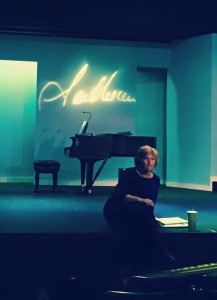
Shannon: You mean other than everything I just said? And the fact that we have a baby grand on stage? The music is spectacular. The talent is very strong. It’s an opportunity for people to just come, sit down, and have fun. We don’t always get to have fun when you go see a show. You really have to emotionally invest your time and energy and turn your brain on real hard to watch certain shows. Following characters and intense storylines, it can be really involved. This show is just right for sitting down and having an evening of easy, enjoyable entertainment. Our whole goal, which I keep saying to everybody, is that I just want everyone to be entertained. Smile and connect. If you mess up, you mess up and the audience will love you even more for it because they’ll be so connected to you from the get-go. It’s really a wonderful show. Come see it!
Side by Side by Sondheim plays through May 17, 2015 at The Vagabond Players— 806 S. Broadway in the heart of Fells Point in Baltimore, MD. For tickets call the box office at (410) 563-9135 or purchase them online.

